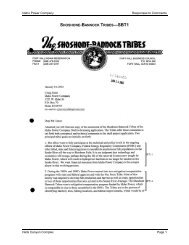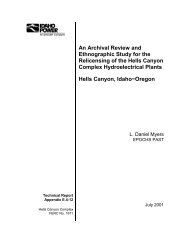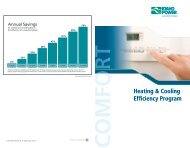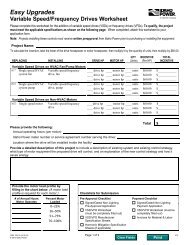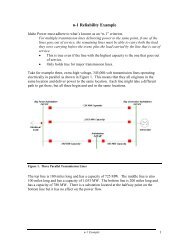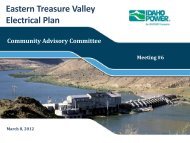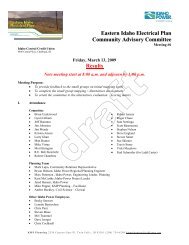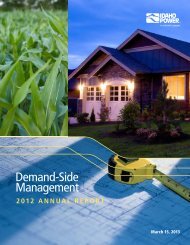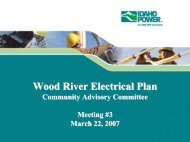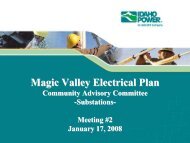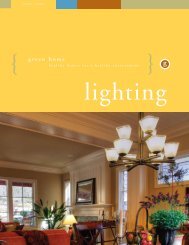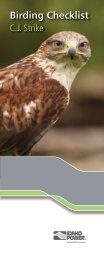Assessment of Chukar and Gray Partridge Populations - Idaho Power
Assessment of Chukar and Gray Partridge Populations - Idaho Power
Assessment of Chukar and Gray Partridge Populations - Idaho Power
- No tags were found...
You also want an ePaper? Increase the reach of your titles
YUMPU automatically turns print PDFs into web optimized ePapers that Google loves.
Hells Canyon <strong>Chukar</strong> <strong>and</strong> <strong>Gray</strong> <strong>Partridge</strong> Report, Ratti <strong>and</strong> Giudice 445.2.3. Habitat EvaluationWe estimated ground cover (100 – percent bare ground) using 3 categories; 80%. Approximately 69% <strong>of</strong> our survey areas had 50-80% ground cover, <strong>and</strong> theremaining 31% had >80% cover. We also conducted an ocular estimate <strong>of</strong> the percent grass,forbs, woody plants, <strong>and</strong> non-vegetated talus <strong>and</strong> rock. Approximately 64% <strong>of</strong> the survey areaswere classified as grass dominated, 5% forbs, 14% woody cover, <strong>and</strong> 17% talus <strong>and</strong> rockoutcroppings. We caution that many <strong>of</strong> the forbs were difficult to detect during fall <strong>and</strong> percentcover was likely underestimated. We also estimated the frequency <strong>of</strong> rock outcroppings as fewor none (1), occasional (2), or abundant (3); the overall average score was 2.25.Our assessment <strong>of</strong> habitat quality was 22% excellent, 46% good, 23% fair, <strong>and</strong> 9% poor.Thus, we concluded that approximately 68% <strong>of</strong> the Hells Canyon region provided good toexcellent habitat for both partridge species. We noted a trend toward poorer habitat scores onmore southerly portions <strong>of</strong> the river. For river miles 256.75-282.0, the average percent <strong>of</strong> habitatwith good or excellent ratings was 68.8%; for miles 286.0-302.5, the average was 66.7%; <strong>and</strong> formiles 306.0-330.0 the average was 41.9%. Poor ratings were generally the result <strong>of</strong> overgrazedsites, especially sites where cattle would congregate for access to water <strong>and</strong> loafing. Other “poorsites” typically were south-facing slopes with poor soils <strong>and</strong> sparse vegetation. We classified(<strong>and</strong> scored) grazing as low (1), moderate (2), heavy (3), or severe (4). Average grazing scorewas 1.96; we observed cattle during 10 (39%) <strong>of</strong> 26 surveys. However, nearly all sites had signsthat indicated cattle grazing had occurred in recent years or earlier in the season. It is importantto note that most survey sites had a range <strong>of</strong> grazing <strong>and</strong> habitat-quality scores; i.e., nearly allsurvey sites contained some high-quality habitat <strong>and</strong> some patches <strong>of</strong> poor habitat. We alsonoted a trend toward increased grazing with more southerly portions <strong>of</strong> the river, i.e., a directrelationship with grazing score <strong>and</strong> river mile (Appendix E, last 2 columns). For river miles256.75-282.0, the average grazing score was 1.5; for miles 286.0-302.5, average score was 1.66;for miles 306.0-330.0 average score was 2.69. As noted above, our scores were based on anocular estimate for the survey region, <strong>and</strong> did not represent systematic collection <strong>of</strong> habitat data.We obtained 2-4 35-mm photographs <strong>of</strong> “typical” habitat conditions at each survey area.These photos may be useful to consider in conjunction with habitat-quality scores. In addition,these photos provide an archival record <strong>of</strong> general habitat conditions during 1999 <strong>and</strong> 2000. Allphotos were submitted with this report to the Environmental Affairs <strong>of</strong>fice <strong>of</strong> <strong>Idaho</strong> <strong>Power</strong>Company, Boise, <strong>Idaho</strong>. Appendix E provides a table <strong>of</strong> habitat scores.5.2.4. Spring Site VisitWe also obtained 1-2 35-mm photographs <strong>of</strong> “typical” habitat conditions during springsite visits. As with fall-survey photos, these photos may provide an archival record <strong>of</strong> generalhabitat conditions during the spring <strong>of</strong> 2000. All spring site-visit photos were taken during a 3-day period 19-21 May 2000. All photos were submitted with this report to the EnvironmentalAffairs Department <strong>of</strong> <strong>Idaho</strong> <strong>Power</strong> Company, Boise, <strong>Idaho</strong>.



